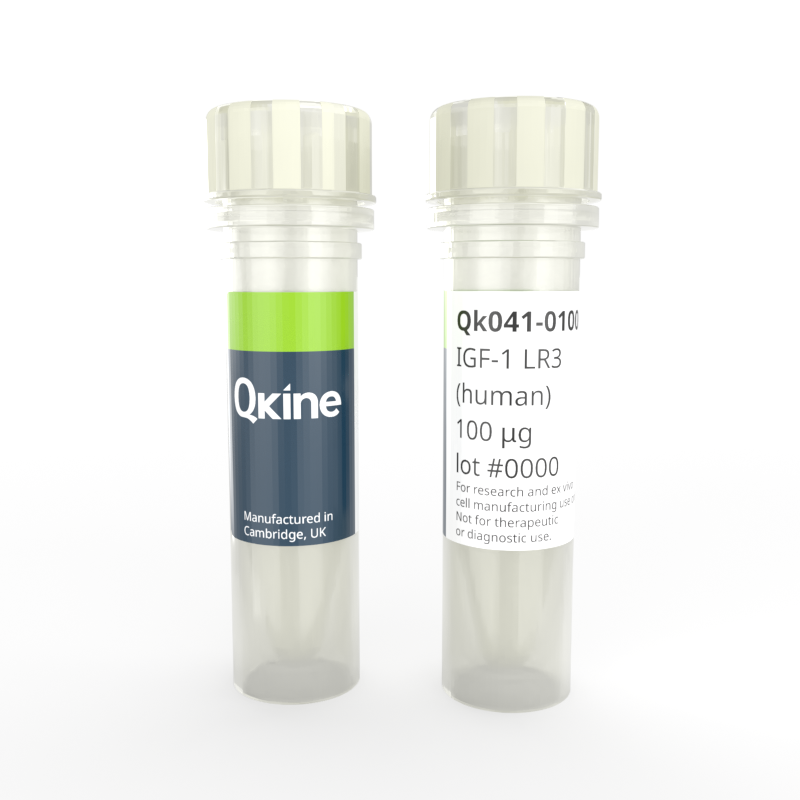Recombinant human IGF-1 LR3 protein
QK041
Brand: Qkine
Human insulin-like growth factor 1 long arginine 3 (IGF-1 LR3) protein is a synthetic analog of IGF-1. The substitutions include an arginine substitution and an N-terminal protein extension. Consequently, IGF-1 LR3 has improved biological potency and extended half-life. IGF-1 LR3 can be used for the consistent, reproducible maintenance of human pluripotent stem cells.
Qkine IGF-1 LR3 is a highly pure and bioactive 9 kDa protein monomer, animal origin-free (AOF) and carrier-protein free (CF).

Currency:
| Product name | Catalog number | Pack size | Price | Price (USD) | Price (GBP) | Price (EUR) |
|---|---|---|---|---|---|---|
| Recombinant human/bovine/porcine IGF-1 LR3 protein, 100 µg | QK041-0100 | 100 µg | (select above) | $ 95.00 | £ 70.00 | € 82.00 |
| Recombinant human/bovine/porcine IGF-1 LR3 protein, 500 µg | QK041-0500 | 500 µg | (select above) | $ 210.00 | £ 155.00 | € 182.00 |
| Recombinant human/bovine/porcine IGF-1 LR3 protein, 1000 µg | QK041-1000 | 1000 µg | (select above) | $ 285.00 | £ 210.00 | € 246.00 |
Note: prices shown do not include shipping and handling charges.
Qkine company name and logo are the property of Qkine Ltd. UK.
Alternative protein names
Species reactivity
porcine (pig)
bovine (cow)
Frequently used together:
Summary
- High purity human IGF-1 LR3 protein (Uniprot: P05019 for IGF-1 wild-type protein)
- 9 kDa
- >98%, by SDS-PAGE quantitative densitometry
- Expressed in E. coli
- Animal origin-free (AOF) and carrier protein-free
- Manufactured in Qkine's Cambridge, UK laboratories
- Lyophilized from acetonitrile, TFA
- Resuspend in sterile-filtered water at >50 µg/ml, add carrier protein if desired, prepare single use aliquots and store frozen at -20 °C (short-term) or -80 °C (long-term).
Featured applications
- Maintenance of pluripotency in iPSC
- Cell culture media optimization and replacement of insulin in defined media
Bioactivity

Purity

Further quality assays
- Mass spectrometry: single species with expected mass
- Analytical reversed-phase: single sharp peak
- Endotoxin: <0.005 EU/μg protein (below level of detection)
- Recovery from stock vial >95%

Qkine IGF-1 LR3 remained bioactive in media for 7 days. Bioactivity was determined using an IGF-1-responsive firefly luciferase reporter assay. Transfected HEK293T cells were treated in triplicate for 4 hours with a serial dilution of IGF-1 LR3 which had been pre-incubated in conditioned media for 7 days. Firefly luciferase activity was measured and normalised to the control Renilla luciferase activity.
Protein background
The insulin-like growth factors (IGFs) are a family of proteins with a similar structure to insulin. IGF-1 has an A and B chain connected by disulphide bonds, its similarity to insulin means it can bind with low affinity to the insulin receptor [1]. IGF-1 is a primary mediator of growth hormone (GH), with growth-promoting effects on most cells and tissues including skeletal muscle, cartilage, bone, liver, kidney, nerve, skin, hematopoietic, and lung [1]. IGF-1 exerts its biological effect through binding to the IGF1 receptor (IGF1R), its effect is modulated through interaction with a group of binding proteins (IGFBPs), which tend to inhibit the effect of IGF-1 [2]. Through IGF1R the Ras-MAPK and PI3 kinase signaling pathways are activated leading to increased cell proliferation and survival [2].
IGF-1 can be used to support maintenance of human embryonic stem cell (ESC) [3] and mesenchymal stem cell (MSC) cultures [3, 4].
Insulin-like growth factor long arginine 3 (IGF-1 LR3), is a widely used synthetic analog of IGF-1 with an arginine replacing glutamic acid at position 3 (arginine 3, R3), and an additional 13 amino acids at its N-terminus (long, L). IGF-1 LR3 retains the ability to bind IGF-1 and insulin receptors but has reduced binding affinity to insulin-like growth factor-binding proteins (IGFBPs). Consequently, IGF-1 LR3 has improved potency and metabolic stability [5].
Background references
- Z. Laron. Insulin-like growth factor 1 (IGF-1): a growth hormone. Mol Pathol. 2001 Oct;54(5):311-6. doi: 10.1136/mp.54.5.311
- H. Werner. The IGF1 Signaling Pathway: From Basic Concepts to Therapeutic Opportunities. International Journal of Molecular Sciences. 2023; 24(19):14882. doi.org/10.3390/ijms241914882
- L. Wang, T.C. Schulz, E. S. Sherrer, D. S. Dauphin, S. Shin, A. M. Nelson, C. B. Ware, M. Zhan, C. Z. Song, X. Chen, S. N. Brimble, A. McLean, M. J. Galeano, E. W. Uhl, K. A. D’Amour, J. D. Chesnut, M. S. Rao, C. A. Blau and A. J. Robins. Self-renewal of human embryonic stem cells requires insulin-like growth factor-1 receptor and ERBB2 receptor signaling. Blood 2007 Dec 1;110(12):4111-9. doi: 10.1182/blood-2007-03-082586
- A. Youssef, D. Aboalola and V. K. Han. The Roles of Insulin-Like Growth Factors in Mesenchymal Stem Cell Niche. Stem Cells Int. (2017) 9453108. doi: 10.1155/2017/9453108
- F. M. Tomas, S. E. Knowles, P. C. Owens, C. S. Chandler, G. L. Francis, L. C. Read and F. J. Ballard. Insulin-like growth factor-I (IGF-I) and especially IGF-I variants are anabolic in dexamethasone-treated rats. Biochem J. 1992 Feb 15:282, 91-7. doi: 10.1042/bj2820091
FAQ
What is IGF-1 LR3?
IGF-1 LR3 is a modified form of IGF-1, it is more potent and stable than unmodified IGF-1.
Where is IGF-1 LR3 found?
IGF-1 LR3 is a synthetic protein and not naturally occurring.
What is the difference between IGF-1 LR3 and IGF-1?
IGF-1 LR3 has an arginine instead of a glutamic acid at the third position in its amino acid sequence and an additional 13 amino acids at its N-terminus. IGF-1 LR3 remains an agonist of the IGF-1 receptor, but it has very low affinity for IGFBPs, which inhibit IGF-1, making it more potent. IGF-1 LR3 also has a significantly longer half-life than IGF-1.
What does IGF-1 LR3 bind to?
IGF-1 LR3 binds to the IGF-1 receptor (IGF1R).
What is the IGF-1 receptor pathway?
IGF1R is linked to various cytoplasmic second messenger molecules including the RAS-MAPK and PI3K signaling networks.
How is IGF-1 LR3 used in cell culture?
IGF-1 LR3 can be used to replace IGF-1 in stem cell cultures. Increased potency and stability means less IGF-1 LR3 is needed compared to unmodified IGF-1.